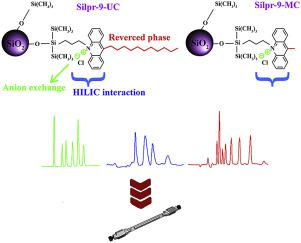Talanta ( IF 5.6 ) Pub Date : 2020-08-02 , DOI: 10.1016/j.talanta.2020.121445 Elham Sadat Hosseini , Kourosh Tabar Heydar

|
In this research, 9-methylacridine and 9-undecylacridine were synthesized through Bernthsen's reaction and well characterized using gas chromatography-mass spectrometry (GC-MS) and nuclear magnetic resonance (NMR). Two mixed-mode stationary phases were developed by functionalizing silica with 9-methylacridine and 9-undecylacridine. Then, two modified silicas were characterized by elemental analysis, thermogravimetric analysis (TGA), and fourier transform-infrared spectroscopy (FT-IR). Due to the extent of conjugative rings, the hydrophobic hydrocarbon chain, and anion exchange sites of 9-methylacridinium and 9-undecylacridinium group on the silica gel of columns, mixed-mode stationary phases were designed with multiple interactions including π-π stacking interaction, reverse phase, hydrophilic interaction, and anion exchange. According to the type of acridine, different interactions may be formed in the target column. Polycyclic aromatic hydrocarbons (PAHs), alkylbenzenes, pyridines and parabens were chromatographed on π-π stacking modes and RPLC, where anion exchange sites can be applied for the separation of inorganic anions on AEC mode. Considering the structure of the stationary phases, these columns were used to separate organic compounds with higher polarity on the HILIC retention. The performance of the columns was investigated by the chromatographic parameters in terms of column efficiency (N/m), asymmetry factor (Af), retention factor (k), and resolution (Rs). The mixed-mode stationary phases can be successfully employed to conduct chromatographic separation on a wide range of samples with a single column.
中文翻译:

在HPLC中使用9-甲基ac啶和9-十一碳lac啶为混合模式固定相进行硅胶改性
在这项研究中,通过伯恩森反应合成了9-甲基ac啶和9-十一碳内酰胺,并使用气相色谱-质谱(GC-MS)和核磁共振(NMR)对其进行了很好的表征。通过用9-甲基ac啶和9-十一碳内酰胺官能化二氧化硅,开发出两种混合模式固定相。然后,通过元素分析,热重分析(TGA)和傅立叶变换红外光谱(FT-IR)对两种改性二氧化硅进行了表征。由于共轭环的范围,疏水性烃链以及硅胶柱上9-甲基rid基和9-十一烷基rid基的阴离子交换位点,设计了混合模式固定相,具有多种相互作用,包括π-π堆积相互作用,反相,亲水相互作用和阴离子交换。根据of啶的类型,可能在目标色谱柱中形成不同的相互作用。多环芳烃(PAHs),烷基苯,吡啶和对羟基苯甲酸酯在π-π堆积模式和RPLC上进行色谱分离,其中阴离子交换位点可用于在AEC模式下分离无机阴离子。考虑到固定相的结构,这些色谱柱用于分离具有较高极性的HILIC保留有机化合物。通过色谱参数研究色谱柱的性能,包括柱效(N / m),不对称因子(A 阴离子交换位点可用于在AEC模式下分离无机阴离子。考虑到固定相的结构,这些色谱柱用于分离具有较高极性的HILIC保留有机化合物。通过色谱参数研究色谱柱的性能,包括柱效(N / m),不对称因子(A 阴离子交换位点可用于在AEC模式下分离无机阴离子。考虑到固定相的结构,这些色谱柱用于分离具有较高极性的HILIC保留有机化合物。通过色谱参数研究色谱柱的性能,包括色谱柱效率(N / m),不对称因子(Af),保留因子(k)和分辨率(Rs)。混合模式固定相可以成功地通过单根色谱柱在各种样品上进行色谱分离。































 京公网安备 11010802027423号
京公网安备 11010802027423号